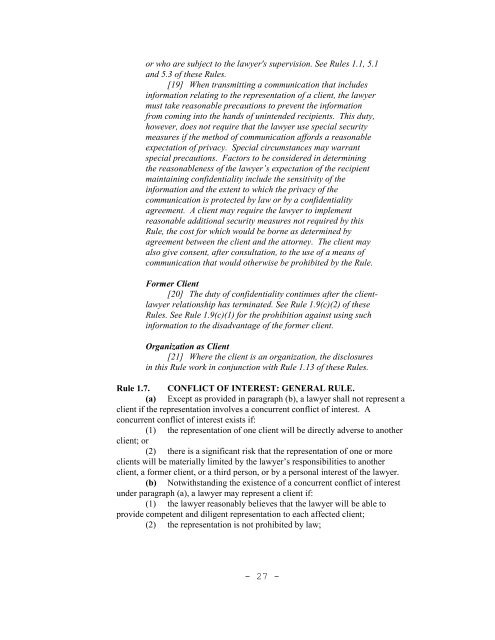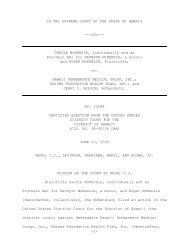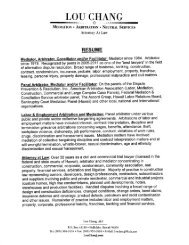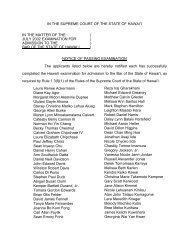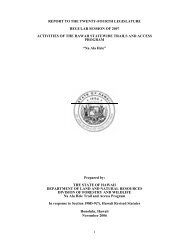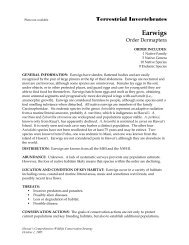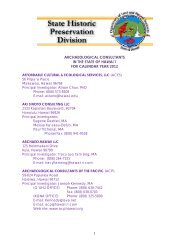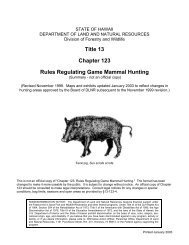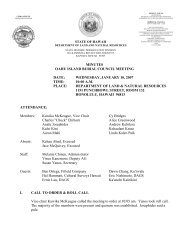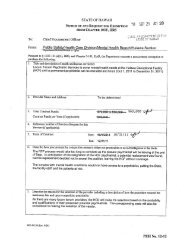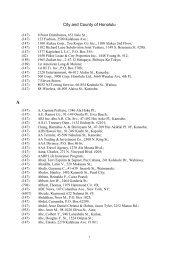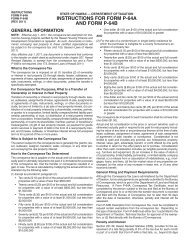amendments to the Hawaii Rules of Professional Conduct
amendments to the Hawaii Rules of Professional Conduct
amendments to the Hawaii Rules of Professional Conduct
You also want an ePaper? Increase the reach of your titles
YUMPU automatically turns print PDFs into web optimized ePapers that Google loves.
or who are subject <strong>to</strong> <strong>the</strong> lawyer's supervision. See <strong>Rules</strong> 1.1, 5.1<br />
and 5.3 <strong>of</strong> <strong>the</strong>se <strong>Rules</strong>.<br />
[19] When transmitting a communication that includes<br />
information relating <strong>to</strong> <strong>the</strong> representation <strong>of</strong> a client, <strong>the</strong> lawyer<br />
must take reasonable precautions <strong>to</strong> prevent <strong>the</strong> information<br />
from coming in<strong>to</strong> <strong>the</strong> hands <strong>of</strong> unintended recipients. This duty,<br />
however, does not require that <strong>the</strong> lawyer use special security<br />
measures if <strong>the</strong> method <strong>of</strong> communication affords a reasonable<br />
expectation <strong>of</strong> privacy. Special circumstances may warrant<br />
special precautions. Fac<strong>to</strong>rs <strong>to</strong> be considered in determining<br />
<strong>the</strong> reasonableness <strong>of</strong> <strong>the</strong> lawyer’s expectation <strong>of</strong> <strong>the</strong> recipient<br />
maintaining confidentiality include <strong>the</strong> sensitivity <strong>of</strong> <strong>the</strong><br />
information and <strong>the</strong> extent <strong>to</strong> which <strong>the</strong> privacy <strong>of</strong> <strong>the</strong><br />
communication is protected by law or by a confidentiality<br />
agreement. A client may require <strong>the</strong> lawyer <strong>to</strong> implement<br />
reasonable additional security measures not required by this<br />
Rule, <strong>the</strong> cost for which would be borne as determined by<br />
agreement between <strong>the</strong> client and <strong>the</strong> at<strong>to</strong>rney. The client may<br />
also give consent, after consultation, <strong>to</strong> <strong>the</strong> use <strong>of</strong> a means <strong>of</strong><br />
communication that would o<strong>the</strong>rwise be prohibited by <strong>the</strong> Rule.<br />
Former Client<br />
[20] The duty <strong>of</strong> confidentiality continues after <strong>the</strong> clientlawyer<br />
relationship has terminated. See Rule 1.9(c)(2) <strong>of</strong> <strong>the</strong>se<br />
<strong>Rules</strong>. See Rule 1.9(c)(1) for <strong>the</strong> prohibition against using such<br />
information <strong>to</strong> <strong>the</strong> disadvantage <strong>of</strong> <strong>the</strong> former client.<br />
Organization as Client<br />
[21] Where <strong>the</strong> client is an organization, <strong>the</strong> disclosures<br />
in this Rule work in conjunction with Rule 1.13 <strong>of</strong> <strong>the</strong>se <strong>Rules</strong>.<br />
Rule 1.7. CONFLICT OF INTEREST: GENERAL RULE.<br />
(a) Except as provided in paragraph (b), a lawyer shall not represent a<br />
client if <strong>the</strong> representation involves a concurrent conflict <strong>of</strong> interest. A<br />
concurrent conflict <strong>of</strong> interest exists if:<br />
(1) <strong>the</strong> representation <strong>of</strong> one client will be directly adverse <strong>to</strong> ano<strong>the</strong>r<br />
client; or<br />
(2) <strong>the</strong>re is a significant risk that <strong>the</strong> representation <strong>of</strong> one or more<br />
clients will be materially limited by <strong>the</strong> lawyer’s responsibilities <strong>to</strong> ano<strong>the</strong>r<br />
client, a former client, or a third person, or by a personal interest <strong>of</strong> <strong>the</strong> lawyer.<br />
(b) Notwithstanding <strong>the</strong> existence <strong>of</strong> a concurrent conflict <strong>of</strong> interest<br />
under paragraph (a), a lawyer may represent a client if:<br />
(1) <strong>the</strong> lawyer reasonably believes that <strong>the</strong> lawyer will be able <strong>to</strong><br />
provide competent and diligent representation <strong>to</strong> each affected client;<br />
(2) <strong>the</strong> representation is not prohibited by law;<br />
- 27


